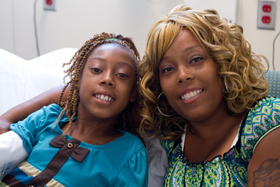
Fourteen-year-old Selina, shown here with mom Yolanda, manages her sickle cell disease with monthly blood transfusions.
Rady Children’s helps teen manage genetic blood disorder
By B.J. Walk
At two weeks of age, Selina Harris-Jordan was diagnosed with sickle cell anemia, a serious blood disorder, which led to a rare brain disease, a stroke by her 10th birthday and the ongoing need for monthly blood transfusions. Put simply, she has faced more medical challenges in her first 14 years than most people do in a lifetime. But when talking with Selina and her mom, Yolanda, you would never know it.
“Selina is so happy, so positive. She doesn’t care about her scar or her port,” said Yolanda, referring to the surgically inserted plastic tube in Selina’s chest for blood transfusions. “A lot of kids would be like, ‘oh no,’ but not Selina.”
Selina is one of 120 kids who receive outpatient treatment at the Comprehensive Sickle Cell Center at Rady Children’s Hospital-San Diego, a program of the Peckham Center for Cancer & Blood Disorders. Jenny Kim, M.D., a pediatric hematologist and the center’s medical director, describes Selina as a sweet, slightly shy girl, who handles her disease very well, despite its many challenges. “It’s something these kids have to deal with all their lives,” she said, noting that sickle cell disease affects the red blood cells that circulate oxygen throughout the body.
A multidisciplinary approach to care helps patients stay as healthy as possible. “We have a team of doctors, including pediatric neurologists, pulmonologists and hematologists, who work with these kids to address the many aspects of this disease,” said Dr.
Kim, also an associate professor of pediatrics at the University of California, San Diego. “In Selina’s case, she receives blood transfusions every month to keep her sickle red blood cells low.”
More than 100,000 Americans and several million people worldwide suffer from sickle cell anemia, a genetic-based disorder that causes the oxygen-carrying red blood cells to become stiff, sticky and misshapen or “sickled” in appearance. This leads to poor blood flow that deprives tissues of oxygen, which can lead to symptoms such as severe pain, difficulty breathing and possible organ damage. It is most common in people of African descent but is also found in Hispanics of Caribbean ancestry and people of Middle Eastern, Asian, Indian, Latin American, Native American, and Mediterranean heritage.
Selina’s mom recalls the early days of her daughter’s diagnosis, shortly after birth. “When I first found out, I didn’t want anybody to breathe on her,” said Yolanda. “I was so afraid of her getting sick.”
But as she learned more, Yolanda became more relaxed, and Selina has enjoyed many typical childhood activities. “She plays tag and catch with her brothers and sisters,” said Yolanda, who is proud of how her daughter handles the disease. “She gets tired a little quicker, but that’s about it. She just flows with it.”
Dr. Kim said kids with sickle cell disease have to be cognizant of their illness due to the risk of painful episodes that can be triggered by heavy physical activity, stress, altitude changes and other factors. “Our patients’ parents often have to take time off work because of flare-ups,” said Dr. Kim. “Sickle cell is not silent.”
Selina enjoys the support of a strong family including her mom, dad and four siblings, ages 4 to 17, as well as a nurturing school environment. She attends Gompers Charter School and is in the special education program, where she is working to overcome some developmental delays caused by her stroke.
Jonathan Bui, M.D., Ph.D., a pediatric neurologist at Rady Children’s and an assistant professor of neurosciences at UC San Diego, noted that cerebral vascular disease can be a major complication of sickle cell anemia. “In Selina’s case, sickle cell led to thickening and narrowing of the carotid arteries, resulting in low blood flow and oxygenation to the brain,” he said.
The reduced blood flow then triggered Moyamoya disease, which means “puff of smoke” in Japanese, a term referring to the tangled appearance of new blood vessels that form in the brain as the body tries to compensate for the low blood flow. “It’s this abnormal blood supply that led to Selina’s stroke,” said Dr. Bui, who recommended surgery to improve the blood flow. Michael Levy, M.D., Ph.D., head of Rady Children’s Division of Neurosurgery and a professor of pediatric neurosurgery at UC San Diego, performed a complex vascular operation, which incorporated a technique developed at Rady Children’s to minimize scarring.
“We used Selina’s temporal muscle and other structures with their own robust vascular supply to enable the body to build new vessels for delivering proper blood flow to the brain,” Dr. Levy said, noting the surgery was successful.
In fact, the only sign of her surgery is a barely visible hairline scar. “They only had to cut one of my braids,” said Selina, who wears several braids with colored ribbons.
Now in 8th grade, Selina enjoys her friends and school, where everyone is well versed on sickle cell thanks to guest educational talks by her mom. “I tell the students that sickle cell is not contagious,” said Yolanda. “If you touch someone with sickle cell, it’s not going to jump on you. It’s in your genes.”
Yolanda and Selina are strong advocates for educating people about the disease. Selina has appeared in a local parade, fashion show and radio program to raise awareness. “If there is another child with sickle cell, I would introduce my child to let them know they are not alone,” said Yolanda. “Just like breast cancer and other diseases, more research needs to be done. I think sickle cell is something everybody should know about.”
Originally published in U-T San Diego, October 2012